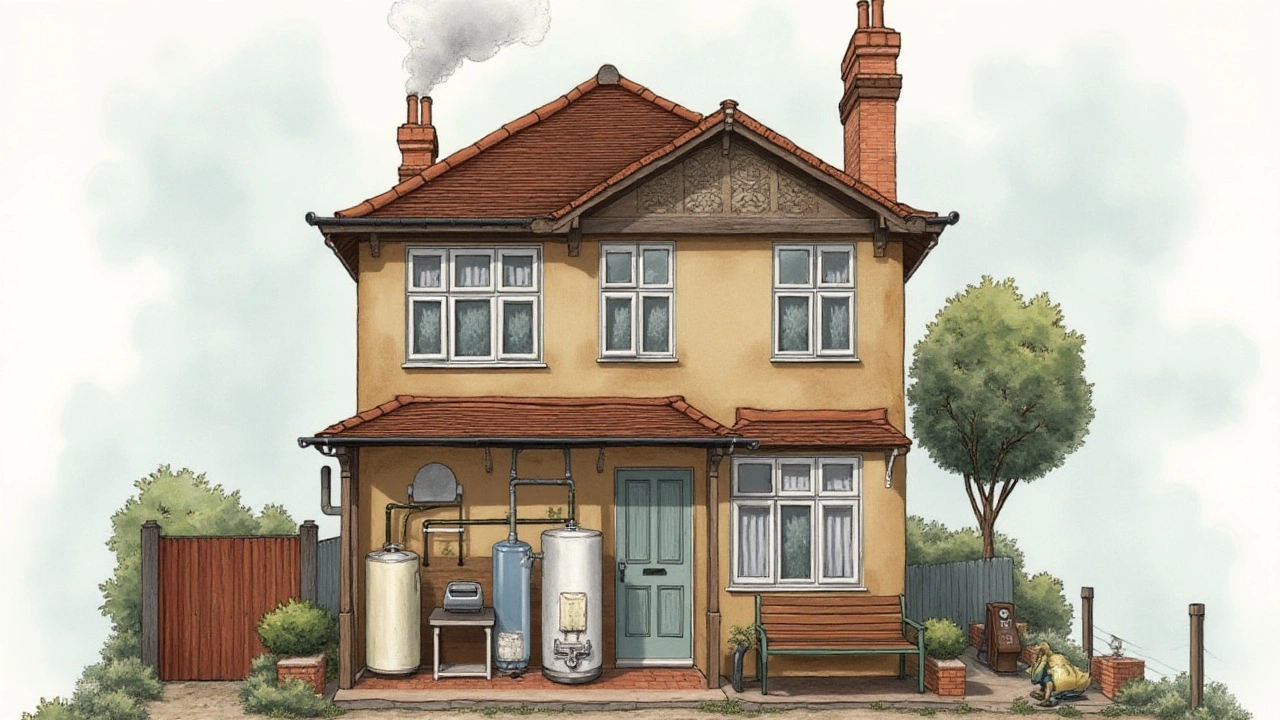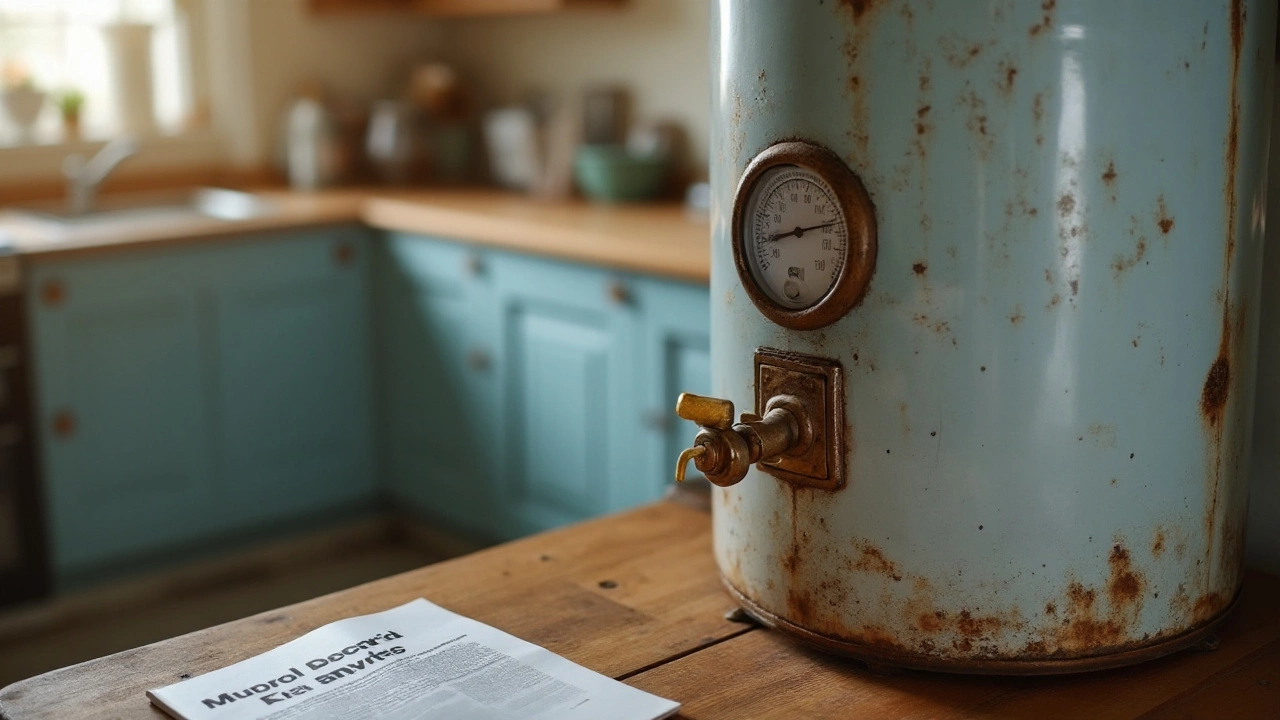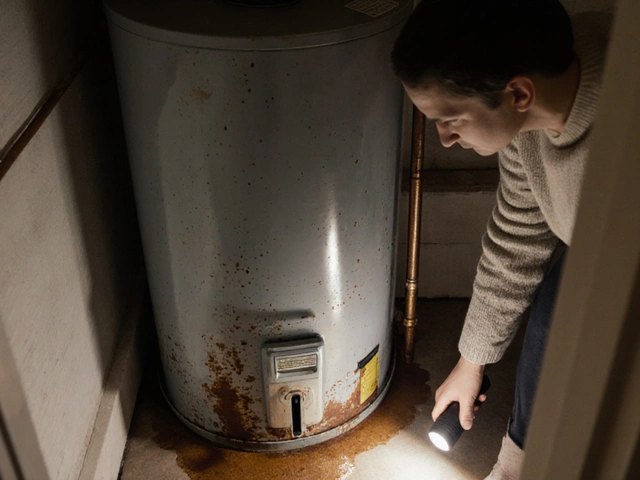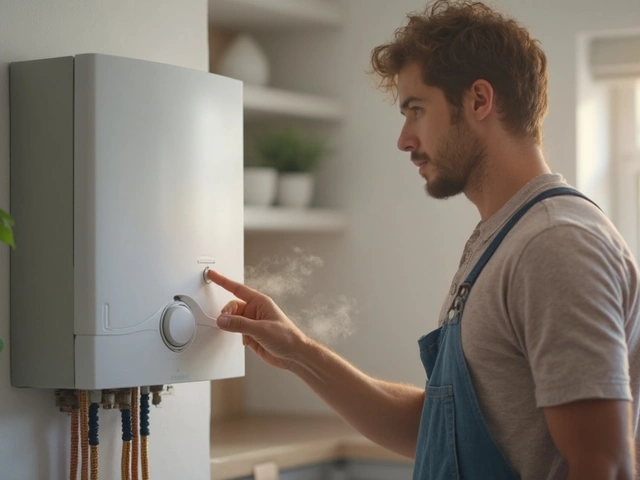The comfort of a warm shower or the ease of hot tap water can be quickly disrupted if your water heater is on the fritz. Knowing when it's time for a replacement is essential, not only for maintaining comfort but also for avoiding further damage or increased utility expenses. The various signs your water heater gives can be subtle or sudden, and recognizing them early can be a game-changer.
Among the most telling indicators are fluctuating water temperatures. If you're no longer receiving a consistently hot supply, it's a warning you shouldn't ignore. Another crucial factor is the age of your unit. Water heaters typically last about 8-12 years, and if yours is pushing the limit, it may be time to consider a new one.
Then there are the odd sounds that can start emanating from a heater. Not just an annoyance, these noises often point to sediment buildup or internal parts beginning to wear out. Leaks and rust around the unit are other big red flags, signaling potential water damage and inefficiency.
Finally, as utility costs climb, an old or faulty heater may guzzle more energy, leading to higher bills. This analysis will lead you through these warning signs and what actions to take, ensuring you have a steady, economical, and reliable hot water supply.
- Recognizing Temperature Issues
- Age Matters: How Old is Your Heater?
- Unusual Noises and Their Meanings
- Leaking and Rust: Warning Signs
- Energy Efficiency and Cost Considerations
Recognizing Temperature Issues
There's nothing more frustrating than stepping into the shower, only to be jolted by an icy stream. If your hot water heater is sending you through an emotional rollercoaster with erratic water temperatures, it's time to delve deeper into the reasons behind this unwelcome surprise. One common culprit for fluctuating temps is sediment buildup inside the tank. This sediment acts as a barrier between the burner and the water, making it feel like you're in a perpetual loop of setting the right heating mode without really ever hitting your stride. Sediment is sneaky—it creeps up on you gradually, often going unnoticed until the hot and cold rotation becomes undeniable.
Another aspect to consider is the thermostat setting. Just like you wouldn't set your house thermostat in the deep chill of winter and expect to feel the warmth of spring, your water heater requires some seasonal adjusting too. If the thermostat isn't set right, or worse—faulty—you might experience temperature inconsistencies that can feel inexplicably capricious. It might be worth checking if your thermostat has a mind of its own. Water heater repair isn't just about fixing visible leaks and corrosion; it also involves getting into the nitty-gritty components like thermostats and heating elements. They might need recalibration or outright replacement to ensure your water runs at just the temperature you need.
Let's talk about energy supply issues. Sometimes the source of your woes might not be the heater itself, but external factors like gas supply inconsistencies or electrical connectivity problems. When troubleshooting, make sure to check the supply chain leading up to your unit. This is especially pertinent in homes where multiple systems rely on the same fuel source. Surprisingly, improper sizing can also cause competing demands on your system. If your heater is too small for your household needs, especially during peak demand times, you'll frequently notice sudden temperature drops.
"Regular maintenance can bypass many typical heater issues," says Mark Thompson, a seasoned plumbing expert. "Taking the time to remove built-up sediment and ensuring proper power connections can save you from unnecessary frustrations and costly replacements."
Considering replacements and repairs brings us to factory defects, a less-common but possible issue. A small percentage of units might not meet performance standards straight out of manufacturing, which clearly manifests in unstable temperature settings. While this is usually covered under warranty, it's not something most users would immediately consider. If after all checks your unit still struggles, consulting with the manufacturer should be on the list. They might provide insights or assistance specific to your model.
Age Matters: How Old is Your Heater?
When it comes to the longevity of your hot water heater, age truly is more than just a number. Like any hardworking appliance in your home, water heaters have a life expectancy, generally averaging between 8 to 12 years. This time frame varies based on several factors including the type of unit, water quality, and maintenance routine. For instance, traditional tank water heaters tend to have a shorter lifespan compared to the tankless models which can last up to 20 years with proper care. It’s crucial to pay attention to this timeline because an aging water heater is more prone to failures. As it ages, components wear and efficiency decreases, which can lead to higher energy costs and inconsistent performance.
Checking the age of your water heater is relatively simple. Most units have a sticker or label displaying the serial number, often on the upper part of the heater. Deciphering the date from a serial number involves knowing the manufacturer’s coding style, as each company has a different format. This small step can avoid homeowners a lot of uncertainty. Manufacturers like Rheem use a date coding system where the month and year are part of the serial number. By understanding these codes, you gain valuable insight into how much longer you might expect your heater to perform reliably. There is wisdom in routinely checking manufacturers' specifications and guidelines to know about your unit's expected lifespan.
Age also plays a critical role when considering repairs versus replacement. There comes a time when throwing more money at repairs on an old unit yields diminishing returns. As a rule of thumb, if a heater is older than 10 years and requires significant repair, it's often a better investment to replace it rather than continue patching up what’s essentially a sinking ship.
According to Angie’s List, 'When you’re looking at repairs costing more than half the cost of a replacement, it’s wise to put your money toward a new water heater.'Making informed decisions not only saves cash but also prevents potential water damage from a failing tank.
For a smart household, keeping track of your water heater's age and the first signs of wear can help in planning for its eventual replacement. Write the installation date down when you first get it, and mark your calendar when it nears the end of its service life. Particularly if your heater comes with modern technology, those models often include a built-in timer or alert system for maintenance, which helps in planning and budgeting for a replacement.
Regular maintenance can also extend the life of your tankless water heaters, especially in areas with hard water. Regular flushing and descaling could potentially stretch some extra years out of their life. Table below provides an average lifespan of different types of heaters across various regions to underline the variability depending on these conditions:
| Type | Average Lifespan | Region (Water Type) |
|---|---|---|
| Traditional Tank | 8-12 years | Hard Water |
| Traditional Tank | 10-15 years | Soft Water |
| Tankless | 15-20 years | Both |

Unusual Noises and Their Meanings
Strange noises emanating from your hot water heater can often be the first clear signal that something isn't quite right. These noises are frequently tied to sediment buildup within the tank. This occurs when minerals from the water supply begin to settle at the bottom of the heater. Over time, as the burner heats the water, the sediment can harden, causing a range of unusual sounds. A popping or rumbling noise is quite common, akin to the sound of boiling water trapped under layers of mineral deposits trying to escape. This isn't just a minor irritant, as layers of sediment can significantly erode the heater's efficiency, which might lead to higher energy bills and lesser amounts of hot water.
As the sediment layers grow thicker, they create an insulating barrier between the burner and the water it needs to heat. This means your heater has to work much harder and run longer to achieve the desired temperature. Some unlucky owners even report hearing banging or clanking, which could indicate the sediment has amassed to the point where it causes structural strain. Frequent flushing of the heater is a preventive measure, yet in longstanding cases, a replacement might be the wiser choice. Understanding these noises isn't just about comfort—it's also about efficiency and safety.
"The lifespan of a hot water heater can be dramatically shortened by sediment build-up," says water heater expert Steven Jennings. "Regular maintenance, including sediment flushing, can extend its life and maintain performance."
In another instance, a high-pitched screeching might arise, usually linked to issues with the inlet control valve. This noise happens when water entering the tank is blocked or restricted, creating an unwelcome pressure buildup. If left unchecked, this can result in wear and tear on the valve itself, elevating the risk of leaks or even burst pipes. Those who hear a hissing sound might have a leaking or cracked tank as water escapes and turns into steam. Steam signifies not just a loss of water but also energy, driving up operational costs unnecessarily. Always keep a keen ear out for such odd auditory warnings.
Sediment Removal Tactics
Dealing with sediment requires a methodical approach. Flushing the heater is the first line of defense. Follow these steps for an effective sediment flush:
- Turn off the heater and allow it to cool.
- Connect a garden hose to the drain valve at the bottom, directing the other end outside or into a large bucket.
- Open the valve and let the water flow until clear. Repeat if necessary.
- Close the valve and remove the hose carefully.
- Refill the tank and restart the heater once complete.
For those unfamiliar with this process, or if problems persist, consulting with a water heater professional can prevent errors that might damage the unit. By maintaining a clean, sediment-free tank, you're not only saving energy but also preserving the lifespan of your hot water heater.
Leaking and Rust: Warning Signs
The sight of a leak or rust on your hot water heater is more than just an inconvenience; it is a red flag that there might be deeper issues at hand. Water heaters are designed to be watertight, so any sign of moisture where it shouldn't be is cause for concern. Over time, tanks can corrode due to their constant exposure to water and heat, especially if they have not been maintained properly. When rust begins to appear, it signifies the breakdown of the tank's material, which can lead to more significant leaks if not addressed promptly. Leaks can also develop from the pressure relief valve which indicates, in some cases, dangerous overpressure situations.
Leakage can stem from several sources including faulty valves, weakened gaskets, or even cracks within the tank itself. If the issue is left untreated, it can cause water damage to your home's structure and possessions. Small leaks might be manageable for the short term, but any considerable moisture should be inspected by a professional immediately. Imagine waking up to a basement full of water or the damaging effects on your flooring, walls, and personal belongings. To avoid such scenarios, it is important to proactively address any signs of leaking and rust.
Rust around the base or on parts of the water heater also provides a critical warning about the tank's integrity. From the tank to the anode rod, these components are prone to rust and, once compromised, can trigger a cascade of failures. Rust inside the system can stain your water, leaving you with unappealing or even unsafe water. Besides the aesthetic and odor issues, rust inside means the tank's internal structure is deteriorating, potentially putting the appliance's safety and function at risk. The anode rod may need replacement to reduce internal deterioration. Regularly checking components and replacing rusted parts can prolong the heater's life.
When considering repair versus replacement, keep in mind the age and condition of your water heater. For units nearing the end of their usable life, which is typically around 8-12 years, it might be more prudent to replace rather than repair. Continued repairs on an aging unit can sometimes cost more in the long run, particularly if recurring issues suggest systemic failures. Here’s a helpful tip: placing a tray or pan under the heater can help catch potential leaks early and minimize damage. If you notice that repairs aren't keeping rust and leaks at bay any longer, the investment in a new, more efficient unit could save you trouble and cost down the line.
Pete Decker, a plumbing expert from Reliable Plumbers, once noted, "A small leak today becomes tomorrow's torrent. Addressing these signs early can save homeowners a world of trouble."
Ignoring these signs of a bad water heater can lead to significant issues and costly repairs. Maintaining a vigilant eye and swift action are keys when encountering leaks and rust. Regular inspections and maintenance, including flushing the system to clear sediment build-up, help prevent many of these problems. If you're noticing any of these warning signs, don’t hesitate to reach out to a professional for a comprehensive assessment to decide the next steps most beneficial to both your home and your wallet.

Energy Efficiency and Cost Considerations
When it comes to your hot water heater, energy efficiency is more than just a buzzword—it's a fundamental aspect that can have a significant impact on your utility bills and environmental footprint. A water heater that's seen better days may consume more energy than necessary, leading you to spend more on heating than you should. This inefficiency can be due to various reasons, including an older, less advanced design, buildup of sediment in the tank, or wear and tear on heating elements.
Energy-efficient models on the market today are designed to maximize heat retention and minimize wastage. Look for units with a higher energy factor (EF) rating, which indicates better performance in maintaining water temperature with minimal energy input. According to the U.S. Department of Energy, replacing an old storage water heater with a new high-efficiency model can save you a whopping 7% to 15% on your energy bills. The immediate cost savings can be enticing, but there's also a long-term benefit to consider: less energy usage means there's a smaller environmental impact, which is a win for both your wallet and the planet.
Beyond replacing old units, there are also some maintenance steps you can take to improve your current water heater's efficiency. Regularly flushing the tank to remove sediment, checking the temperature settings (keeping them around 120°F), and inspecting for leaks or rust can significantly enhance performance. These steps not only keep your water heater running smoothly but also extend its lifespan, delaying the need for a costly replacement.
"Investing in an energy-efficient water heater today is not just an expense—it's an investment into a more sustainable future," notes Jill Notini from the Association of Home Appliance Manufacturers.
Making informed decisions about your home's energy use, particularly surrounding your water heater, is crucial. It's not just about reacting when problems arise but also proactively ensuring that your system is as effective as it can be. Embracing new technologies like tankless water heaters, which only heat water when needed, can lead to even more savings. Although the upfront cost can be higher, the long-term savings often offset this initial expense.
| Type | Annual Energy Costs (average) |
|---|---|
| Conventional Storage | $400 - $600 |
| Tankless | $200 - $400 |
| Heat Pump | $100 - $140 |
No matter which path you choose, maintaining an energy-efficient home is key to minimizing utility costs and embracing a responsible lifestyle. Consider your water heater as a vital part of your home ecosystem—one that, when optimized, can provide comfort and savings simultaneously.




